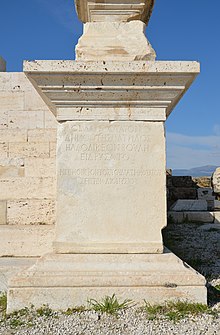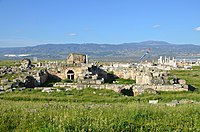Laodicea on the Lycus
Λαοδίκεια πρὸς τοῦ Λύκου (in Greek) Laodikeia (in Turkish) | |
 Colonnaded street in Laodicea | |
| Location | Eskihisar, Denizli Province, Turkey |
|---|---|
| Region | Phrygia |
| Coordinates | 37°50′09″N 29°06′27″E / 37.83583°N 29.10750°E |
| Type | Settlement |
Laodicea on the Lycus (
Since 2002, Pamukkale University has continued archaeological excavations, followed by intensive restoration work.[1]
In 2013 the archaeological site was inscribed in the
It contained one of the Seven churches of Asia mentioned in the Book of Revelation.[3]
Location
Laodicea is situated on the long spur of a hill between the narrow valleys of the small rivers Asopus and Caprus, which discharge their waters into the Lycus.
It lay on a major trade route[4] and in its neighbourhood were many important ancient cities; it was 17 km west of Colossae, 10 km south of Hierapolis.[5] and 160 km east of Ephesus. It was situated in the ancient region of Phrygia, although some ancient authors place Laodicea in differing provincial territories, not surprising because the precise limits of these territories were both ill-defined and inconstant; for example, Ptolemy[6] and Philostratus[7] call it a town of Caria, while Stephanus of Byzantium describes it as belonging to Lydia.
History




Laodicea on the Lycus was built on the site of an earlier pre-Hellenistic settlement, on a hill above the
After the
During the Roman period, Laodicea was the chief city of a Roman
The wealth of its inhabitants engendered a taste for the arts of the
The area often suffered from earthquakes, especially from the great shock that occurred in the reign of Nero (60 AD) in which the town was completely destroyed. However, the inhabitants declined imperial assistance to rebuild and restore the city by their own means.[25]
The martyrdom of Lulianos and Paphos is believed to have happened here.
The
It was fortified by the Emperor Manuel I Komnenos.[26] In 1206–1230, it was ruled by Manuel Maurozomes.[27] The city was destroyed during the invasions of the Turks and Mongols.[28]
Christianity at Laodicea



With its large Jewish community,[29] Laodicea very early became a seat of Christianity and a bishopric. The Epistle to the Colossians mentions Laodicea as one of the communities of concern for Paul the Apostle.[30] It sends greetings from a certain Epaphras from Colossae, who worked hard for the Christians of the three Phrygian cities of Colossae, Laodicea ad Lycum and Hierapolis.[31] Asking for greetings to be sent to the Laodicean Christians,[32] the writer requests that his letter be read publicly at Laodicea (Colossians 4:16) and that another letter addressed to the Laodiceans (see Epistle to the Laodiceans) be given a public reading at Colossae.[33] Some Greek manuscripts of the First Epistle to Timothy end with the words: "Written at Laodicea, metropolis of Phrygia Pacatiana".[34] Laodicea is also one of the seven churches of Asia mentioned in the Book of Revelation.[35]
The first three bishops attributed to the see of Laodicea are very uncertain, their names recalling people mentioned in the New Testament: Archippus (Colossians 4:17); Nymphas, already indicated as bishop of Laodicea by the Apostolic Constitutions of the last quarter of the 4th century[36] (a man named Nymphas or, according to the best manuscripts, a woman named Nympha is mentioned in Colossians 4:15); and Diotrephes (3 John 9). After these three comes Sagaris, martyr (c. 166). Sisinnius is mentioned in the Acts of the martyr Saint Artemon, a priest of his church. Nunechius assisted at the Council of Nicaea (325). Eugenius, known by an inscription, was probably his successor. Constantius transferred the Arian Cecropius to the See of Nicomedia.[34]
When Phrygia was divided into two provinces, Laodicea became the metropolis of
Sixty canons of a
The Site





The existing remains attest to its former greatness. Its many buildings include a stadium, baths, temples, a gymnasium, two theatres and a bouleuterion (Senate House). On the eastern side, the line of the ancient wall may be distinctly traced, with the Ephesus gate's remains; streets traverse the town, flanked by colonnades and numerous pedestals. North of the town, towards the Lycus, are many sarcophagi, with their covers lying near them, partly embedded in the ground, and all having long been rifled.
The West theatre has been recently restored (2022) with virtually complete banks of stone seats.[
Also, much of the vast 35,000 m2 west (or central) agora has been restored with many of its tall 10.8 m columns.[40] The 100 m long and 11 m high back wall is covered with frescoes and is considered important for world archaeology.
Particularly interesting are the remains of an
In 2015, a rare marble block was found with the inscription of the water law. Issued in 114 AD, it regulated the use of water imported from the mountains to Laodicea on pain of 5 to 12.5 thousand
The stadium/hippodrome near the city's southern extremity is in a good state of preservation. The seats are arranged along two sides of a narrow valley, which was taken advantage of for this purpose and was closed up at both ends. Towards the west are considerable remains of an underground passage by which chariots and horses could be admitted into the arena, with a long inscription over the entrance.
Immediately north of the stadium lies a gymnasium complex coupled with twin baths peculiar to the region. It is linked to the south agora on its north side and a bouleuterion. An inscription shows the ensemble was built for Hadrian's visit in 135.
In 2019 a statue of Roman emperor Trajan was unearthed at the site.[41]
Notable people
- Polemon of Laodicea, a sophist
- Menander Rhetor, rhetorician
- Varus of Laodicea (Ancient Greek: Οὔαρος), a sophist[42]
- Antiochus of Laodicea (Ancient Greek: Ἀντίοχος), philosopher[43]
- Theiodas of Laodicea (Ancient Greek: Θειωδᾶς), philosopher[43]
- Heras of Laodicea (Ancient Greek: Ἡρᾶς), fighter[44]
Notes
- ^ Laodicea, World Archaeology Issue 41 https://www.world-archaeology.com/features/laodicea/
- ^ "Archaeological site of Laodikeia". UNESCO World Heritage Centre. Retrieved 19 June 2018.
- St. Paul, Ep. ad Coloss. ii. 1, iv. 15, foll.; Apocal. iii. 14, foll.
- ^ Strabo 14.2.19.
- ^ Antonine Itinerary p. 337; Tabula Peutingeriana; Strabo xiii. p. 629.
- ^ v. 2. § 18.
- ^ Lives of the Sophists i. 25
- ISBN 978-0-19-954556-8.
- ISBN 9780520293946.
- ^ Fant, Clyde E, and Mitchell G Reddish, 'Laodicea', A Guide to Biblical Sites in Greece and Turkey (New York, 2003; online edn, Oxford Academic, 12 Nov. 2020), https://doi.org/10.1093/oso/9780195139174.003.0036 Pages 232–240
- ^ Josephus, Ant. Jud., xii.3.4.
- ^ Cicero Pro Flacco 28-68
- ^ "Laodicea".
- ^ Appian, Bell. Mithr. 20; Strabo xii. p. 578.
- ^ Cicero Epistulae ad Familiares ii. 1. 7, iii. 5
- ^ Strab. xii.8.16
- ^ Vitruvius viii. 3.
- ^ Revelation 3, 14-18
- ^ Cicero ad Fam. iii. 7, ix. 25, xiii. 54, 67, xv. 4, ad Att. v. 15, 16, 20, 21, vi. 1, 2, 3, 7, In Verrem i. 30.
- ^ Comp. Fellows, Journal written in Asia Minor, p. 280, foll.
- ^ William Martin Leake, Asia Minor, p. 251, foll.
- Diogenes Laërtiusix. 11. § 106, 12. § 116.
- ^ Strabo xii. p. 580.
- ^ Strabo, Geography, 12.8.16
- ^ Tacitus, Annals. xiv. 27.
- ^ Nicet. Chon. Ann. pp. 9, 81.
- ISBN 9781139499354.
- ^ William Smith (1873). A Dictionary of Greek and Roman Geography. Vol. 2. John Murray. p. 122.
- ^ Josephus Ant. Jud. xiv. 10, 20; Hierocl. p. 665.
- ^ Colossians 2:1
- ^ Colossians 4:12–13
- ^ Colossians 4:15
- ^ Colossians 4:16
- ^ a b c Sophrone Pétridès, "Laodicea" in Catholic Encyclopedia (New York 1910)
- ^ Revelation 1:11, 3:14–22
- ^ Apostolic Constitutions, 7:46
- ISBN 978-88-209-9070-1), p. 913
- ^ Laodicea in Phrygia
- ^ In Coloss,, ii, 18, Patrologia Latina, LXXXII, 619,
- ^ Sacred agora unearthed in Laodicea https://www.hurriyetdailynews.com/sacred-agora-unearthed-in-laodicea-108030
- ^ "La ciudad antigua de Laodicea se hará subir a los estándares de Éfeso". 28 March 2019.
- ^ Suda, omicron, 766
- ^ a b Diogenes Laertius, Lives of the Philosophers, 9.116
- ^ Greek Anthology Book 16.52
External links
 This article incorporates text from a publication now in the public domain: Smith, William, ed. (1854–1857). "Laodiceia". Dictionary of Greek and Roman Geography. London: John Murray.
This article incorporates text from a publication now in the public domain: Smith, William, ed. (1854–1857). "Laodiceia". Dictionary of Greek and Roman Geography. London: John Murray.- Hazlitt, Classical Gazetteer, "Laodicea"
- Jewish Encyclopedia, "Laodicea" Archived 2007-11-15 at the Wayback Machine
- . Collier's New Encyclopedia. 1921.
- "HTML5 Panaoramas taken in December, 2012 Laodicea on the Lycus"
- "Photos from the ancient ruins - Taken May 2015


